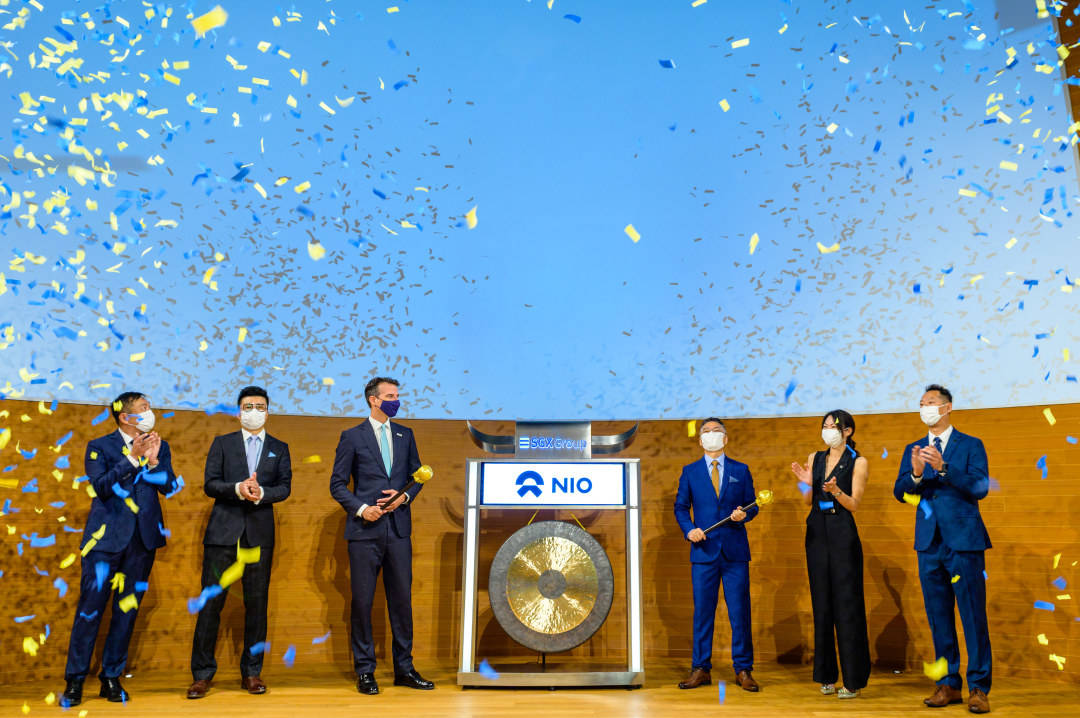Author: Zhang Yi
On May 20th, NIO was successfully listed on the Main Board of the Singapore Exchange, which means that NIO has become the first Chinese company to be listed on the New York Stock Exchange, Hong Kong Stock Exchange and Singapore Stock Exchange.
This listing on the Singapore Stock Exchange did not involve the issuance of new shares but was done through the introduction of the existing old shares for trading. The related shares can be completely interchangeable with its American shares listed on the New York Stock Exchange.
This listing method can shorten the listing time, and at the same time, it will not dilute the interests of existing shareholders. It can also help NIO to increase trading locations, provide more choices for international investors, further deepen the layout of the global capital market, and broaden the future overseas financing channels and platforms.
It is understood that NIO also used the same introduction method for its listing on the Hong Kong Stock Exchange on March 10th this year. With two listings in the first half of this year, NIO’s determination for its global expansion can be seen, as well as the international capital market’s optimism about the new energy vehicle industry.
NIO’s Global Expansion
NIO founder Li Bin said, “With Singapore’s important strategic position in the global capital market, NIO has further improved its global capital market layout. We will also leverage the advantages of Singapore’s international economic and technological center and conduct deep cooperation with local scientific research institutions to establish an artificial intelligence and autonomous driving research and development center in Singapore, further improving NIO’s global R&D and business layout.”
At present, NIO has established design, research and production centers in 12 cities including San Jose, Munich, London, Beijing and Shanghai.
This listing in Singapore is not only to further improve its capital market layout but also to focus on Singapore’s domestic technological strength to help NIO’s layout in research and development, especially in the research and development of artificial intelligence and autonomous driving.
The automotive industry is a highly globalized industry. NIO’s overseas research and development layout focuses on cutting-edge fields such as autonomous driving.
On the other hand, autonomous driving is a key and core factor for new car makers and an important indicator to measure their new car-making ability. It is also one of the main fortresses for new car makers to compete in technology layout.
NIO chose the road of independent research and development early on and gave up cooperation with international companies such as Bosch. They placed the R&D center in North America. In 2019, due to the difficulty in sustaining huge resource investment, NIO shifted its R&D focus from North America to China and increased its R&D investment in Shanghai, Beijing, Hefei and other places. They also have an autonomous driving R&D center in the core area of Silicon Valley, San Jose, with an area of over 187,000 square feet.
NIO’s autonomous driving is mainly composed of four teams: hardware, operating system and data security, algorithms and system engineering. After the departure of the head of the system engineering team, Zhang Jianyong, in April this year, the rest of the autonomous driving team was reorganized.# Singapore’s Advantage in Self-Driving Technology
Singapore, with small land area but a huge population density, has conducted extensive research on transportation to improve its efficiency. It proposed the “Singapore Autonomous Vehicle Initiative” to explore the feasibility, regional transportation system, and technical and legal policies surrounding self-driving vehicles.
According to a report by KPMG, Singapore ranks first in the world in the maturity of self-driving technology. In 2016, Singapore launched the world’s first public self-driving taxi Robotaxi trial. The public could book 6 Robotaxis through a ride-hailing app and travel 6 kilometers, making Singapore the first country in the world to actually deploy Robotaxis.
In 2017, Singapore revised the “Road Safety Act” to allow for testing of self-driving cars on public roads. With abundant technological resources from two world-leading universities, the National University of Singapore and Nanyang Technological University, Singapore has made significant breakthroughs in the field of self-driving technology. Moreover, with strong governmental support, Singapore has become a global hub and leading example in this area.
As a result of the strong cooperation between industry, academia and research institutions, many companies related to autonomous driving, including nuTonomy, Delphi, Foresight Technologies, NavInfo, Volvo, Peugeot Citroen, and ComfortDelGro, have set up offices in Singapore.
Li Bin, chairman and founder of Chinese EV company NIO said that 2023 and 2024 will be the time for the new energy car industry to enter the “finals”, and capital and technology are essential. Whether NIO, which is listed in three places, can stand out in the new car market remains to be seen.
This article is a translation by ChatGPT of a Chinese report from 42HOW. If you have any questions about it, please email bd@42how.com.
